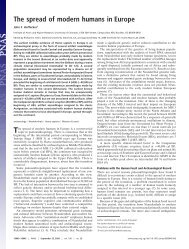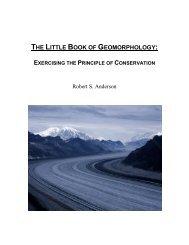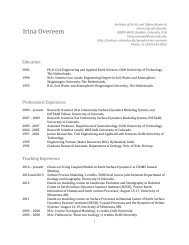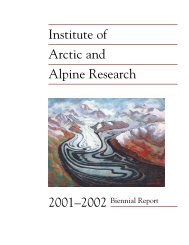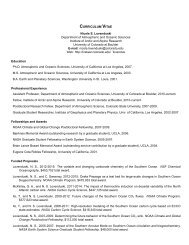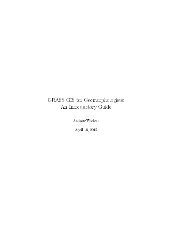Glacier Mass Balance and Regime: Data of Measurements and ...
Glacier Mass Balance and Regime: Data of Measurements and ...
Glacier Mass Balance and Regime: Data of Measurements and ...
You also want an ePaper? Increase the reach of your titles
YUMPU automatically turns print PDFs into web optimized ePapers that Google loves.
were found between published <strong>and</strong> recalculated values <strong>of</strong> glacier area, seasonal components, <strong>and</strong> annualmass balances. The results <strong>of</strong> these comparisons are given in Table 2.1.<strong>Data</strong> on mass-balance variables versus altitude are basic for calculation <strong>of</strong> variables for an entireglacier, <strong>and</strong> it is unfortunate that it has not become the rule to publish all such results <strong>of</strong> measurementsalong with results averaged over entire glacier area.Results presented in Appendices 2 <strong>and</strong> 3 were basically obtained using the glaciological method.Still, there are many modifications <strong>of</strong> the method in use, at least eleven, according to ∅strem <strong>and</strong>Brugman (1991). It is difficult (if not impossible) to reconstruct what modification were used to getvalues for any particular glacier <strong>and</strong> year. The original definitions <strong>of</strong> variables have generally beenpreserved in Appendices 2 <strong>and</strong> 3; these indicate the system used in field work <strong>and</strong> data presentation. Inthese appendices, b n, b w, b s, means the annual, winter <strong>and</strong> summer balances in either the stratigraphic,fixed-date, or combined systems (Mayo et al, 1972). In several cases the annual values <strong>of</strong> snowaccumulation, ablation, mass balance (c t, a t, b a) are given. <strong>Data</strong> obtained by the “alpine system” aregiven as a c(net accumulation), a a(net ablation), <strong>and</strong> b n(net balance). Obviously, substantial differencesexist between seasonal variables as shown above, but b ais nearly equal to b n, by the definition <strong>of</strong> themethod.2.5. HOW PRECISE CAN MASS-BALANCE DATA BE?The usual approach to the estimation <strong>of</strong> data quality is to compare data obtained by one methodwith one or more independent measurements. One common approach is to verify data obtained by theglaciological method by comparing them with the results <strong>of</strong> repeated geodetic/topographic surveys. Thishas been done for several glaciers in the world. The comparisons shown in Table 2.2 suggest that, ingeneral, the two methods only give comparable results for a few cases (glaciers <strong>and</strong> periods).Discrepancies between the two methods may have different signs (plus <strong>and</strong> minus) for different glaciers<strong>and</strong> for different periods. For some glaciers the discrepancy is large (Blue, Storbreen), but for others it isvery small (Careser, Djankuat). There are several reasons discussed in detail by Golubev et al., 1978;Andreassen, 1999; Conway et al, 1999; Krimmel, 1999; ∅strem <strong>and</strong> Haakensen, 1999; <strong>and</strong> others. Oneimportant conclusion from these comparisons <strong>and</strong> discussions is that the topographic method may serveas a control for many cases. Obviously two methods are needed to get sufficient data control.The case <strong>of</strong> Alfotbreen is <strong>of</strong> special interest. The calculated mass balance for this glacier appliesto about 25% <strong>of</strong> the entire Alfotbreen ice cap area (∅strem <strong>and</strong> Haakensen, 1999). The accumulation38



